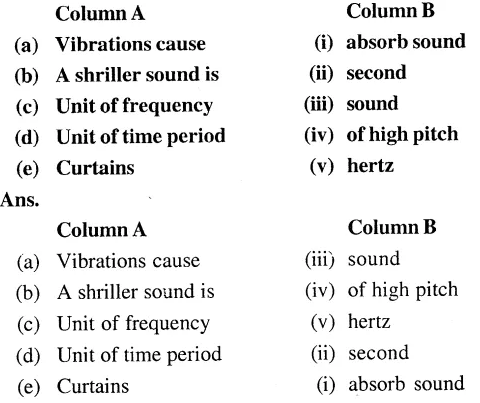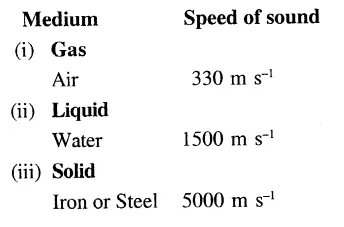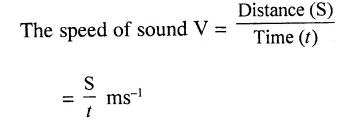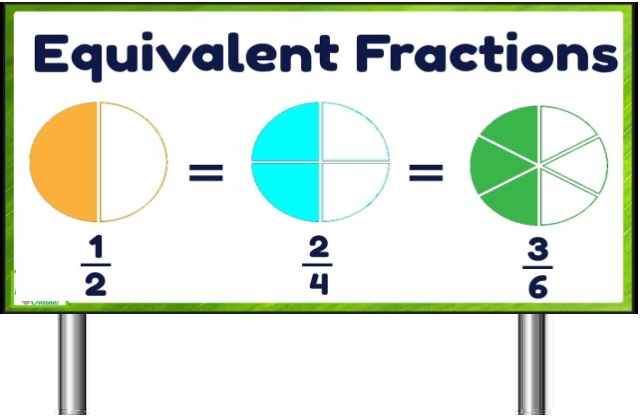Sound ICSE Class-7th Concise Selina Physics Solutions Chapter-6. We Provide Step by Step Answer of Objective, True False , Fill in the blanks, Match the following , Short / Long Answer, Numerical s of Exercise-6 Sound. Visit official Website CISCE for detail information about ICSE Board Class-7.
Sound ICSE Class-7th Concise Selina Physics Solutions Chapter-6
A. Objective Questions Chapter-6 Sound ICSE Concise Selina
1. Write true or false for each statement
(a) Sound can travel in vacuum.
Answer. False.
Correct — Sound requires medium to travel.
(b) Sound is a form of energy.
Answer. True.
(c) Sound can only be produced by vibrating bodies.
Answer. True.
(d) Larger is the amplitude, feeble is the sound.
Answer.False.
Correct — Larger the amplitude, greater is the sound.
(e) The frequency is measured in hertz.
Answer. True.
(f) Loudness depends on frequency.
Answer. False.
Correct — Loudness depends on the amplitude.
(g) Waveforms of two different stringed instruments can be the same.
Answer. False.
Correct—Waveforms of two different stringed instruments cannot be the same.
(h) Female voice is shriller than the male voice.
Answer. True.
(i) A ticking clock sound is heard late when heard through a metal.
Answer. False.
Correct—A ticking clock sounds is heard early when heard through a metal.
2. Fill in the blanks Sound ICSE Class-7th Concise
(a) Sound is produced when a body vibrates.
(b) The number of times a body vibrates in one second is called its frequency.
(c) The pitch of a sound depends on its frequency.
(d) Sound can travel in a medium solid, liquid or gas.
(e) We can hear sounds of frequency in the range of 20 Hz to 20,000 Hz.
(f) Sound requires a medium for propagation.
(g) Sound travels faster in solids than in liquids.
(h) The sound heard after reflection is echo.
(i) Sound produces sensation in ears
3. Match the following Sound ICSE Class-7th Concise

4. Select the correct alternative Sound ICSE Class-7th Concise
(a) We can distinguish a shrill sound from a flat sound by its
amplitude
loudness
pitch
none of the above.
Answer
pitch
(b) We can hear sound of frequency
10 Hz
500 Hz
100,000 Hz
50,000 Hz
Answer
500 Hz
(c) Sound cannot travel in
gases
liquids
solids
vacuum
Answer
vacuum
(d) The minimum distance required between the source and the reflector so as to hear the echo in air is
10m
17m
34 m
50 m
Answer
17m
(e) Wavelength is measured in
kg
second
litre
metre
Answer
metre
(f) The speed of sound in water is
332 m
1500 m
5000 m s
1000 m s
Answer
1500 m
(g) Sound travels the fastest in
liquids
solids
gases
vacuum
Answer
solids
B. Short/Long Answer Questions Sound ICSE Class-7th Concise
Question 1.
What do you mean by a vibratory motion ?
Answer:
The oscillatory motion in which the body assumes a new shape during its motion, is called the vibratory motion.
Question 2.
What is sound ?
Answer:
Sound is a form of energy which produces the sensation of hearing.
Question 3.
How is sound produced ?
Answer:
Sound is produced by vibrating bodies.
Question 4.
Describe an experiment to show that each source of sound is a vibrating body.
Answer:
Sound is produced when a body vibrates. In other words, each source of sound is a vibrating body. This can be demonstrated by the following experiment.
Take a ruler. Press its one end on the table with the left hand as shown in figure. Pull down the other end of the ruler with the right hand and then leave it.
You will notice that the ruler vibrates i.e., the ruler moves to and fro and a humming sound is heard.
After some time, the ruler stops vibrating. No sound is then heard.
After some time, the ruler stops vibrating. No sound is then heard.
Question 5.
Name two sources of sound.
Answer:
Each vibrating body is a source of sound. We, the human beings, produce sound when our vocal cords vibrate on blowing air through them by our lungs. Some animals like birds, frogs etc., also produce sound due to vibration of their vocal cords. But bees do not have the voice-boxes. They produce sound by moving their wings up and down very fast.
Question 6.
How do we produce sound ?
Answer:
Our throat has a larynx. The voice is produced in the larynx. Larynx is also called the voice box. It is designed to produce voice. It is a box like structure with walls of tough tissues. Inside two folds of the tissue, there is a gap. They are the vocal cords. When we breathe, the vocal cords become loose and the gap between them increases. When we talk, shout or sing, the cords become tight and hence they vibrate, thus produce sound. Given figure shows the part of the body which vibrates to produce sound.
Question 7.
The bees do not have voice-boxes. How do they produce sound ?
Answer:
The bees do not have the voice-boxes. Still they produce sound.
This happens by the vibrations produced by the quick movement of their wings. Bees buzz while flying and depositing pollen among flowers.
Question 8.
Answer:
Experiment — Arrange an electric bell, a glass bell jar, a vacuum pump, a battery and a switch as shown in the figure. When the circuit is closed by pressing the switch, the bell starts ringing and sound can be heard. Now remove the air from the jar with the help of vacuum pump. The loudness of the sound gradually decreases and a stage comes when no sound is heard. Sound requires a medium to travel but cannot travel in vacuum
Connect the bell to a battery through a switch. On pressing the switch, the bell starts ringing and a sound is heard. The sound reaches us through the air in the jar.
Now start the vacuum pump. It withdraws the air from the jar. You will notice that as the jar is evacuated, the sound becomes feeble and feeble. After some time when no air is left within the jar, no sound is heard. However, the hammer of the electric bell can be still seen striking the gong. The reason is that when no air is left in the jar, the sound does not reach us, although the bell is still ringing (or vibrating).
Thus, sound cannot travel through a vacuum.
Question 9.
Describe an experiment to show that sound can travel in water.
Answer:
Take a tub filled with water. Hold a bell in one hand and dip it in water. Keep one of your ears gently on the surface of water without letting water into the ear. Now ring the bell inside water. You will be able to hear the sound clearly. This shows that sound can travel through liquids.
Question 10.
Describe an experiment to show that sound can travel in a solid.
Answer:
Take two empty ice-cream cups. Make a small hole at the bottom of each cup and pass a long thread (about 20 m long) through them. Tie a knot or match-stick at each end of the thread so that the thread does not slip out through the holes. This makes a toy – telephone
Now use the toy-telephone as shown in figure and talk to your friend. You will be able to hear the sound of your friend. This shows that sound travels through the thread and reaches your ear. Thus, sound can travel through a solid.
Question 11.
Can two person hear each other on moon’s surface ? Give reason to support your answer.
Answer:
No, we cannot hear each other since sound requires medium for transmission. It cannot travel through vacuum.
Question 12.
What is a longitudinal wave ?
Answer:
In a longitudinal wave, the particles of air vibrate to and fro about their mean positions in the direction of travel of sound.
Question 13.
Define the following terms :
Amplitude, Time period, Frequency.
Answer:
(a) Amplitude (A) : The maximum displacement of a wave on either side of its mean position is called Amplitude. A = XY is amplitude.
(b) Time Period (T) : Time taken to complete one vibration is called Time Period, i.e. from A to B
(c) Frequency (f) or u
Number of oscillations made by a wave in one second is known as its frequency.
Question 14.
Write the audible range of frequency for the normal human ear.
Answer:
The range of frequency from 20 Hz to 20,000 Hz is called the audible range for the normal human ear.
Question 15.
What are ultrasonics ? Can you hear the ultrasonic sound ?
Answer:
Sounds of frequency higher than 20,000 Hz are called the ultrasonics. We cannot hear the ultrasonic sounds.
Question 16.
What are infrasonics ? Can you hear them ?
Answer:
Sounds of frequency lower than 20 Hz are called the infrasonics. We cannot hear the infrasonic sounds.
Question 17.
How does a bat make use of ultrasonics waves to find its way?
Answer:
Use of ultrasonics by bats : Bats have no eyes. But they easily move about without colliding with any object (or obstacle). The reason is that they produce ultrasonic sound as they fly. When this ultrasonic sound comes back after reflection from any object (or obstacle) in their way, they hear it and thus they detect the presence of the object (or obstacle).
Question 18.
Name the two characteristics of sound which differentiate two sounds from each other.
Answer:
A sound wave is characterized by its amplitude and frequency. Depending upon the (amplitude and frequency of the sound wave, the following two characteristics of sound :
(1) Loudness, and (2) Pitch.
Question 19.
On what factor does the loudness of a sound depend ?
Answer:
The loudness of a sound depends on the amplitude of vibration of the vibrating body producing the sound.
Question 20.
How does the loudness of sound produced depend on the vibrating area of the body ?
Answer:
The loudness of sound also depends on the area of the vibrating body. Greater the area of the vibrating body, louder is the sound produced.
If you take two drums, one small and the other big, and beat both of them to produce vibrations in them, We will notice that the sound produced from the big drum is louder than that produced from the small drum. In temples, you must have noticed that the bell with a big case produces a louder sound than that with a small case.
Question 21.
The outer case of the bell in a temple is made big. Give a reason.
Answer:
The outer case of the bell in a temple is made big. So that there is multiple reflection of sound and the sound can be amplified.
Question 22.
State the factors on which the pitch of a sound depends.
Answer:
The pitch of a sound depends on its frequency (i.c., on the frequency of the vibrating body).
Question 23.
Differentiate between a high pitch sound and a low pitch sound.
Answer:
Higher the pitch, the shriller is the sound. Lower the pitch, the flat (or grave) is the sound.
Question 24.
How does a man’s voice differ from a woman’s voice ?
Answer:
A female voice is shriller than a male voice because of higher frequency. Higher is the frequency, shriller is the sound. Female has higher frequency.
Question 25.
Name the characteristic which differentiates two sounds of the same pitch and same loudness.
Answer:
The quality is the characteristic of sound which distinguishes the two sounds of the same pitch and same loudness.
Question 26.
You recognize your friend by hearing his voice on a telephone. Explain.
Answer:
We can recognize our friend by hearing his voice on a telephone due to quality of sound and pitch of sound.
Question 27.
A musician recognizes the musical instrument by hearing the sound produced by it, even without seeing the instrument. Which characteristic of sound makes this possible ?
Answer:
It is the pitch and quality that helps a musician recognize the musical instrument by hearing the sound produced by it, even without seeing the instrument.
Question 28.
Describe an experiment to show the production of sound having low and high pitch.
Answer:
Take few rubber bands some thicker and longer, few thinner and of shorter length. Cut and stretch these rubber bands by holding one end of the string in your mouth under the teeth and the other end in your hand. Now pluck these rubber bands one by one. The rubber bands thicker and longer will produce sound with a lower pitch. The rubber bands thinner and shorter will produce sound with a higher pitch.
Question 29.
How does a musician playing on a flute change the pitch of sound produced by it ?
Answer:
In musical instruments like flute and clarinet, the pitch of sound is changed by changing the length of vibrating air column when different holes in it are closed.
Question 30.
Why are musical instruments provided with more than one string ?
Answer:
The stringed instruments are provided with a number of strings of different thickness and under different tensions so that each string produces sound of a different pitch.
Question 31.
How can the pitch of sound produced in a piano be changed ?
Answer:
In a piano, the string is struck to make the string vibrate and produce sound. The pitch of sound produced can be changed by stretching or loosening the strings of piano.
Question 32.
Explain why you can predict the arrival of a train by placing your ear on the rails without seeing it.
Answer:
The sound produced by the moving wheels of train travels much faster through the track than through the air. Therefore they hear through the track much before it is heard through the – air.
Question 33.
Write the approximate speed of sound in (i) air, (ii) water and (iii) steel.
Answer:

Question 34.
During a thunderstorm, the sound of a thunder is heard after the lightning is seen. Why ?
Answer:
The velocity of light is 3 × 108 m/s whereas velocity of sound is 332 m/s. First we see the flash of light and then we hear the thunder.
Question 35.
Describe an experiment to estimate the speed of sound in air.
Answer:
To estimate the speed of sound in air suppose we choose two hills A and B about a kilometer apart. A person at the hill A fires a gun. Another person at the hill B starts a stop watch as he sees the flash of the fire and stops it on hearing the sound. Thus, he measures the time interval between the seeing of flash and hearing of the sound. Let it be t second. Then measure the distance between the hills A and B. Let it be S metre.

Experimentally, it is found that the speed of sound in air is nearly 330 m s-1
Question 36.
Can sound travel through solids and liquids ? In which of these two does it travel faster ?
Answer:
Sound travels with highest speed in — solids.
and Sound travels with lowest speed in — gases.
Question 37.
What do you mean by reflection of sound ?
Answer:
Reflection of Sound— When a sound wave strikes a rigid surface, it retraces from its path is called reflection of sound.
Question 38.
State one use of reflection of sound.
Answer:
The reflection of sound is used in making the speaking tube (or
megaphone), sound board and trumpet.
Question 39.
What is echo ?
Answer:
Echo is the sound heard after reflection from a rigid surface such as a cliff, a hillside, the wall of a building etc.
Question 40.
What minimum distance is required between the source of sound and the reflecting surface to hear an echo ? Give reason.
Answer:
Since sound has to travel an equal distance in going up to the reflecting surface and in coming back from the reflecting surface, therefore it must travel nearly 33/2 = 16.5 m either way. Thus, to hear the echo clearly in air, the reflecting surface should be at a minimum distance of 16.5 m from the source of sound.
Question 41.
List four substances which are good absorbers of sound.
Answer:
When sound falls on sofa, fluffs and light substances such as clothes, papers, thermocol, coating of plaster of paris, carpets, curtains, furniture, wood etc., they absorb the sound to a good extent. These are called good absorbers of sound.
Question 42.
List the measures that you will take when designing a sound-proof room.
Answer:
In order to design such a sound proof room we take the following measures
(1) The roof of the enclosure must be covered by plaster of paris after putting the sheets of thermocol.
(2) The walls of the enclosure should be covered by the wooden strips.
(3) The floor must be laid down by thick carpets.
(4) The machine parts of all the electrical equipment such as fan, air conditioner etc. must be placed outside the enclosure.
(5) Thick curtains should be used to cover the doors and keep them closed.
(6) Thick stripping must be used to cover the openings of doors and windows.
C. Numericals Sound ICSE Class-7th Concise
Question 1.
A boy fires a gun and another boy at a distance of 1020 m hears the sound of firing the gun 3 s after seeing its smoke. Find the speed of sound.
Answer:
Speed= distance\ time
speed= 1020\3 = 340 m\s
Question 2.
A boy on a hill A fires a gun. The other boy on hill B hears the sound after 4 s. If the speed of sound is 330 m s-1, find the distance between the two hills.
Answer:
Speed, v = 330 m s-1
t = 4s
Distances = v × t
= 330 × 4s = 1320 m Ans.
Return to – ICSE Class-7 Selina Physics Solution
Thanks
Please share with your friends




